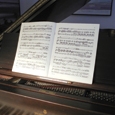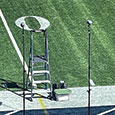There is a reason why playing from memory is often referred to as playing from the heart. To play from the heart musicians use the brain in a different way than when playing with music. In both cases they have to know the music intimately. There are different paths to memorizing, and learning where your strengths and weaknesses lie within auditory, visual and muscle memory will help you capitalize on these talents and discover what needs work. Memorizing leads to countless benefits and becomes much easier with practice.
Devise a Timeline
Divvy up the piece into sections and assign deadlines for how much music you want to learn per week. Full run-throughs should be possible at least one month prior to a competition or performance. Figure out how much you need to memorize each week to be ready by then. There is a huge advantage to using the same piece for multiple competitions or performances, sometimes for years in a row. I do it. Violinist Joshua Bell does it for performances all the time. Ninety-five percent of the time when you hear a professional play a piece from memory, he has performed that piece from memory countless times.
Put Muscle Memory and Auditory Memory Together
Sing through the piece out loud. Finger through the piece. Then sing through and finger through together. Finger through and sing through the piece along with a recording. I once memorized the slow movement of an Albinoni Sonata by whistling and fingering it while in airports. Whistling in public is less obtrusive than playing the flute.
Be Able to Start Anywhere
Photocopy the music and cut it into 4 to 16 measure sections. Place strips in a paper bag and shake the bag. Pull a section randomly from the bag, start there, and play to the end. The ability to start anywhere will be extremely helpful should you get asked to jump to a different place in an audition or if you have a memory lapse.
Visual Stimulation
Know where difficult spots or transitions take place on the physical page. Often I hear a voice in my head saying “Top of the 3rd page, mysterioso.” If I work on it, I can see what the page looks like in my head. Practice one phrase at a time and then swivel the stand away or close your eyes to visualize it.
Be Invested in the Music
When you think only about memorizing notes instead of feeling and expressing the music, chances for success drop radically. Practice feeling the emotions and exerting the musicality you want to convey. Expressive playing generally will not just happen on stage for most people – especially not in difficult sections. I find that when my brain focuses on the music, there is a lesser chance that a negative inner voice will enter with something like, “you have trouble here; what are the notes? Oh my goodness, what’s the next note?”
Sections that are Repetitive, but Slightly Different
If there is a passage that happens several times, but is slightly different each time, study the score looking at the form again and analyzing what is the same and what is different. Sometimes I make up a little song to help me with the differences such as “Second time dominant” or “Third time F#.” Then drill the sequence of passages many times. Sometimes I think about how these small differences affect the story or emotion that I want to convey.
Think Like a Singer
The brain treats a melody entirely differently when there are words. Make up words for difficult sections as sometimes it is easier to memorize this way. It might make the performance more musical as well.
Colors
Some people find that thinking in colors works really well. They imagine blue and yellow sections instead of A and B sections or phrases.
Slow Practice
Practice challenging technical sections slowly from memory. I mean as slow as ¼ the tempo. It is a great test, especially for those who rely on muscle memory predominantly. What seems to flow at a quick pace, may not be accurate when exposed at a slower speed.
Regular Complete Runs
About one month before the performance, I like to be able to run through my music from memory every day. Don’t avoid problem sections.
Write It Down
Write down trouble spots from memory on staff paper or with a computer music writing program. Include all markings. This will help with visual memory.
Test Performances
The most important part of developing a memorized performance is playing for people. Get a memory buddy. You play for him. He plays for you. While I hate asking, I will always do it. Play for friends, studio mates, and your teacher. Drag people into your practice room. If you wait until you feel you are ready, you will never be ready. These low-pressure run-throughs are to work out all the kinks and little memory issues that happen when we get nervous. Pick people who make you nervous. Organize run-throughs any place where there is a piano such as a senior center or library.
Record Yourself
When listening to the playback, conduct along with the recording. If you can’t conduct it, that might indicate a problem. Listen for rhythm, intonation and dynamics.
Provide Distractions
At one performance a bat flew underneath the seats of the audience, and everyone freaked out and jumped out of their chairs. I kept on going. On another occasion, one audience member in the third row snored through the entire first movement of one of the most important concerts of my career. Create distractions to practice concentration. Play the piece while your earbuds are playing something else, or play with the TV or radio on.
Simulate Nerves
Run down the hallway or jog in place and then attempt to play from memory. Exercise elevates the heart rate and simulates a performance situation. For wind players who need to breathe, an elevated heart rate can change everything.
Recordings (Again)
Play along with recordings (North American recordings are usually preferable for pitch.) Finger along with recordings. Sing along with recordings. Record yourself playing with the recording.
Memory Lapse?
If you have a memory lapse in a practice session, start the entire piece over after going over the trouble spot. Some friends allegedly heard violinist Midori play the same passage for hours one morning after making one small mistake in concert.
Practice at Varying Tempos
This will be very helpful for situations that involve minimal rehearsal time with collaborators. When performing a concerto, tempos can vary widely, which will affect muscle memory and breathing.
Rehearsing with the Pianist
Schedule a rehearsal as soon as possible. This might be months or weeks before the performance. I scheduled ten performances of the Ibert concerto with a pianist once before playing it with orchestra.
Practical Tips
Commit to learning and performing a piece from memory and do not look back. As you prepare, decide where you are going to look in the hall when performing. If there is a balcony, look at the balcony. If you practice from memory looking at the floor for endless hours, chances are your head will be down in performance. If you are performing in an unfamiliar hall, check online to see if you can find photos of the space. If you are performing with a conductor or pianist, you will need to communicate with him or her, so your eyes will need to be open. Don’t practice with your eyes closed all the time. In addition, if you are playing with piano at competitions, some jury members may find it offensive if you play with your eyes closed. It is fine to occasionally glance at a jury member, but do not stare them down.
Remember that playing from memory is a creative venture and should enhance the performance. Always have fun when performing, both with and without the music.
* * *
Getting Started: Score Study
Obtain two copies of the score: one for you and one for the pianist. Study the score away from the flute. Identify the form and mark the phrases. Create a story line if that helps. Make note of all dynamics, articulation and expressive markings. Play from the score. Learn to play and sing the tutti sections of concertos and the piano interludes from flute and piano compositions. Know the music, and do not simply count the rests of these sections. Skipping the rests in practice will lead to incorrect entrances when playing with an accompanist. Analyze the harmony and harmonic rhythm. Score study is especially imperative for those who memorize by muscle memory. It is also likely that score study is what this group dislikes doing most.
Listening with the Score
While listening, watch the score rather than the flute part. Find as many recordings as possible. Utilizing YouTube is not enough. You may even have to order CDs in the mail for recordings not available online (and walk up hill to school both ways).





